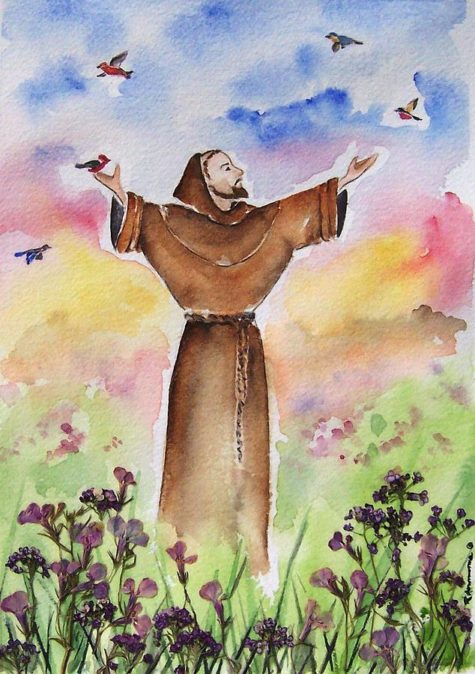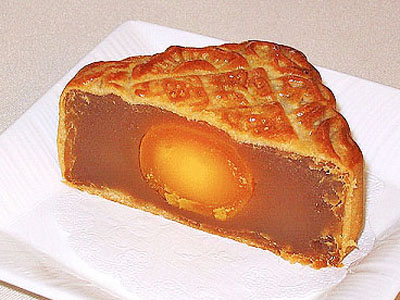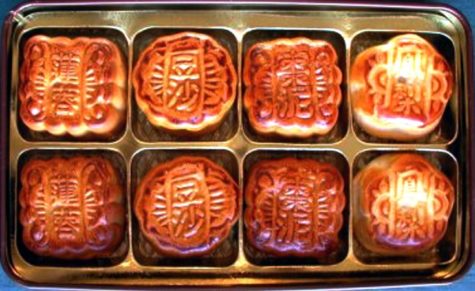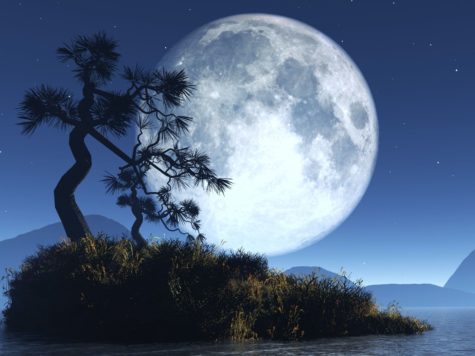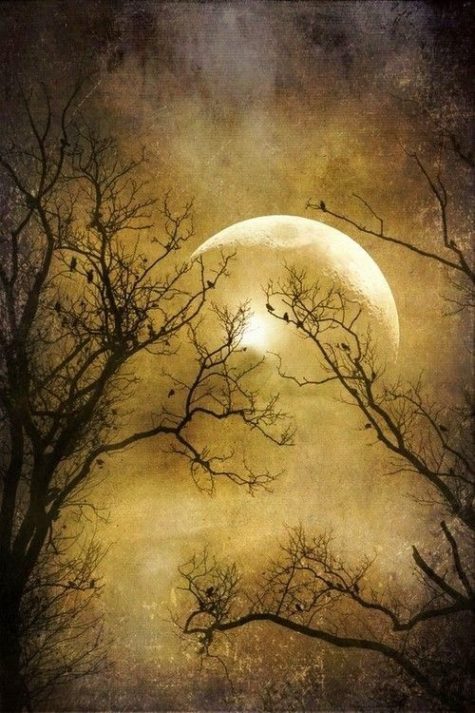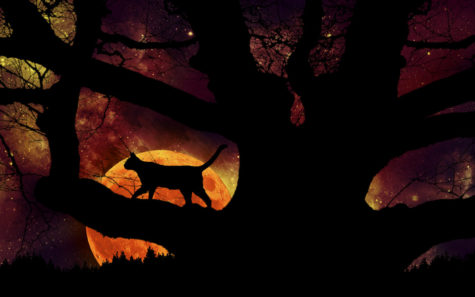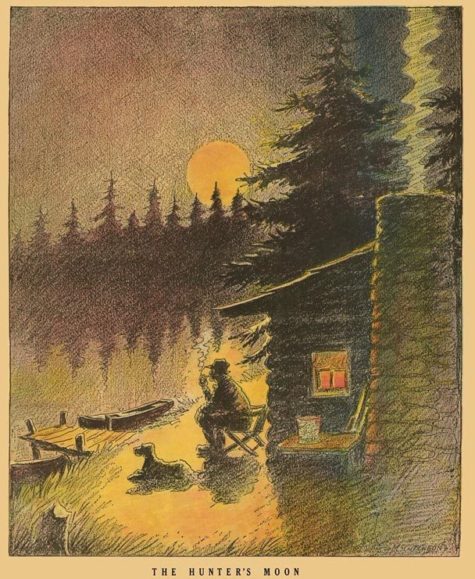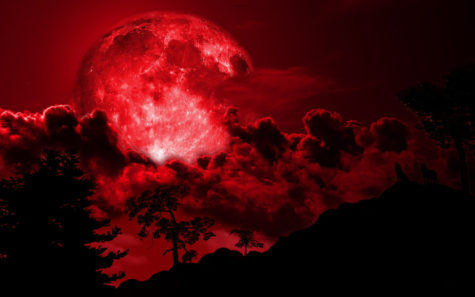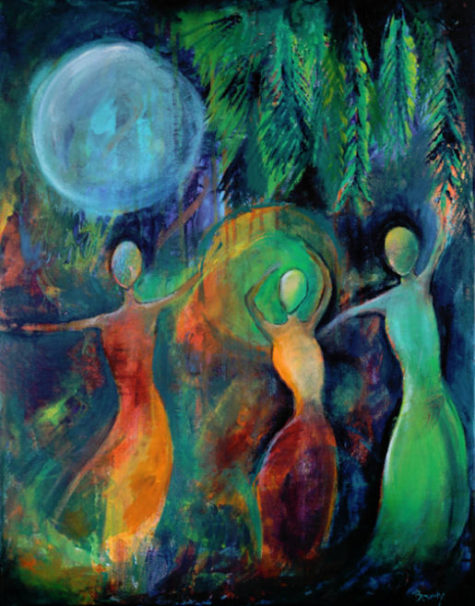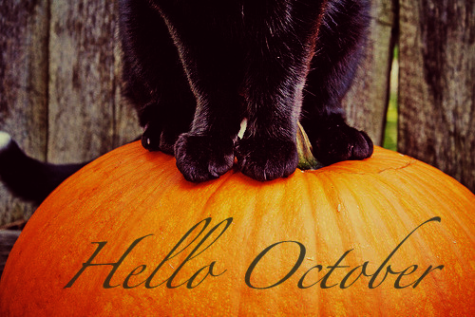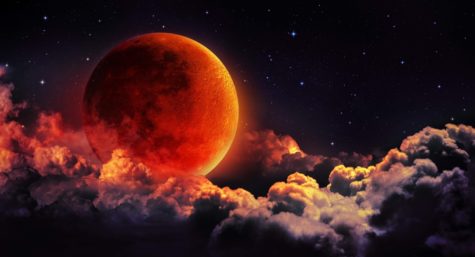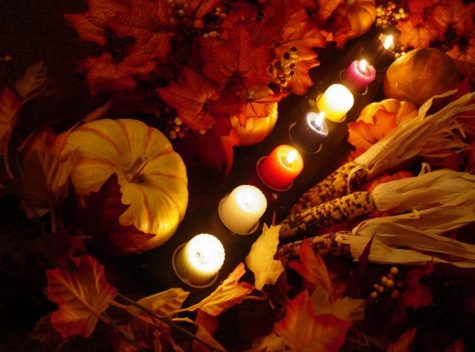Monthly Archives: October 2017
Many churches celebrate the Feast of St Francis of Assisi on October 4 each year. The feast commemorates the life of St Francis, who was born in the 12th century and is the Catholic Church’s patron saint of animals and the environment. It is a popular day for pets to be “blessed”.
About St Francis
St. Francis of Assisi (1182-1226) was the founder of the Franciscan Order. The son of a wealthy merchant named Pietro di Bernardone, he publicly denounced his father’s wealth in 1206 and dedicated his life to prayer and serving the poor. Pope Innocent III eventually gave Francis and his followers permission to preach, and he ordained Francis a deacon. The followers of Francis were called Friars Minor, or “the lesser brethren.” Francis died on October 3, 1226, and was canonized in 1228.
Text from his Sermon to the Birds:
“My little sisters, the birds, much bounden are ye unto God, your Creator, and always in every place ought ye to praise Him, for that He hath given you liberty to fly about everywhere, and hath also given you double and triple rainment; moreover He preserved your seed in the ark of Noah, that your race might not perish out of the world; still more are ye beholden to Him for the element of the air which He hath appointed for you; beyond all this, ye sow not, neither do you reap; and God feedeth you, and giveth you the streams and fountains for your drink; the mountains and valleys for your refuge and the high trees whereon to make your nests; and because ye know not how to spin or sow, God clotheth you, you and your children; wherefore your Creator loveth you much, seeing that He hath bestowed on you so many benefits; and therefore, my little sisters, beware of the sin of ingratitude, and study always to give praises unto God.”
-Saint Francis of Assisi (c.1220)
From: Almanac.com Continue reading
Here is a traditional recipe for the Mid-Autumn Moon Cake
Filling:
- 1 can (17-1/2 ounces) lotus seed paste
- 1/4 cup finely chopped walnuts
Dough:
- 4 cups all-purpose flour
- 1/2-cup non-fat dried milk powder
- 3 teaspoons baking powder
- 1/2 teaspoon salt
- 3 eggs
- 1 cup sugar
- 1/2 cup solid shortening, melted and cooled
- 1 egg yolk , lightly beaten
- Mix lotus seed paste and walnuts together in a bowl; set aside.
Sift flour, milk powder, baking powder, and salt together into a bowl. In large bowl of electric mixer, beat eggs on medium speed until light and lemon colored. Add sugar; beat for 10 minutes or until mixture falls in a thick ribbon. Add melted shortening; mix lightly. With a spatula, fold in flour mixture. Turn dough out on a lightly floured board; knead for 1 minute or until smooth and satiny. Divide dough in half; roll each half into a log. Cut each log into 12 equal pieces.
To shape each moon cake, roll a piece of dough into a ball. Roll out on a lightly floured board to make a 4-inch circle about 1/8-inch thick. Place 1 tablespoon of lotus seed paste mixture in center of dough circle.
Fold in sides of dough to completely enclose filling; press edges to seal. Lightly flour inside of moon cake press with 2-1/2 inch diameter cups. Place moon cake, seam side up, in mold; flatten dough to conform to shape of mold. Bang one end of mold lightly on work surface to dislodge moon cake. Place cake on ungreased baking sheet. Repeat to shape remaining cakes. Brush tops with egg yolk.
Bake in a preheated 375 degree F. oven for 30 minutes or until golden brown. Transfer to a rack and let cool. Makes 2 dozen
Copyright Yan Can Cook, Inc. 1991.
- 1/4 cup sugar
- 2 egg yolks
- 1/2 cup salted butter
- 1 cup all-purpose flour
- 1 cup strawberry (or your favorite) jam
(traditionally red bean paste is used so if you want a more authentic version, you can use a can of red bean paste instead of the jam)
Directions:
- Preheat the oven to 375 degrees.
- Combine the butter, sugar and 1 egg yolk and stir.
- Mix in the flour.
- Form the dough into one large ball and wrap it in plastic wrap.
- Refrigerate dough for half an hour.
- Unwrap the chilled dough and form small balls in the palms of your hand.
- Make a hole with your thumb in the center of each mooncake and fill with about half a teaspoon of jam.
- Brush each cake with the other beaten egg yolk and place on a cookie sheet.
- Bake for about 20 minutes or just until the outside edges are slightly brown
Makes 24
Source: Unknown
The Mid-Autumn Festival, also known as the Moon Festival, is a popular East Asian celebration of abundance and togetherness, dating back over 3,000 years to China’s Zhou Dynasty. In Malaysia and Singapore, it is also sometimes referred to as the Lantern Festival or “Mooncake Festival.”
The Mid-Autumn Festival falls on the 15th day of the 8th lunar month of the Chinese calendar (usually around mid- or late-September in the Gregorian calendar), a date that parallels the Autumn Equinox of the solar calendar. The moon festival is celebrated on the full moon closest to the Autumn Equinox, which sometimes falls in October. This is the ideal time, when the moon is at its fullest and brightest, to celebrate the abundance of the summer’s harvest. The traditional food of this festival is the mooncake, of which there are many different varieties.
The Moon Festival is full of legendary stories. Legend says that Chang Er flew to the moon, where she has lived ever since. You might see her dancing on the moon during the Moon Festival. The Moon Festival is also an occasion for family reunions. When the full moon rises, families get together to watch the full moon, eat moon cakes, and sing moon poems. With the full moon, the legend, the family and the poems, you can’t help thinking that this is really a perfect world. That is why the Chinese are so fond of the Moon Festival.
The Moon Festival is also a romantic one. A perfect night for the festival is if it is a quiet night without a silk of cloud and with a little mild breeze from the sea. Lovers spend such a romatic night together tasting the delicious moon cake with some wine while watching the full moon. Even for a couple who can’t be together, they can still enjoy the night by watching the moon at the same time so it seems that they are together at that hour. A great number of poetry has been devoted to this romantic festival. Hope the Moon Festival will bring you happiness.
Farmers celebrate the end of the summer harvesting season on this date. Traditionally, on this day, Chinese family members and friends will gather to admire the bright mid-autumn harvest moon, and eat moon cakes and pomeloes together. Accompanying the celebration, there are additional cultural or regional customs, such as:
- Eating moon cakes outside under the moon
- Putting pomelo rinds on one’s head
- Carrying brightly lit lanterns
- Burning incense in reverence to deities including Chang’e
- Planting Mid-Autumn trees
- Collecting dandelion leaves and distributing them evenly among family members
- Lighting lanterns on towers
- Fire Dragon Dances
- Shops selling mooncakes, before the festival, often display pictures of Chang’e floating to the moon.
Stories behind the festival can be found at Widdershins:
The Moon Cake Uprising
In late Yuan Dynasty (1271 – 1368 AD), people in many parts of the country could not bear the cruel rule of the government and rose in revolt. Zhu Yuanzhang, founder of Ming Dynasty (1368 – 1644 AD), united the different resistance forces and wanted to organize an uprising. However, due to the narrow search by government, it was very difficult to pass messages.
The counselor Liu Bowen later though out the great idea of hiding notes with “uprise on the night of August 15th” in moon cakes and had them sent to different resistance forces. The uprising turned to be very successful and Zhu was so happy that he awarded his subjects with moon cakes on the following Mid-Autumn Festival. Since then, eating moon cakes has been a custom on Mid-Autumn Festival.
Sources: Wikipedia and Travel China Guide
What follows is a list (in alphabetical order) of the names given to the October moon. Also listed is the tradition and/or origin of that moon name:
- Blood Moon ~Mediaeval English, Neo-Pagan
- Blood Moon Falling ~Janic (full)
- Corn Ripe Moon ~Taos
- Falling Leaves Moon ~Arapaho
- Full Dying Grass Moon ~Algonquin Native American, Colonial
- Harvest Moon ~When closest to the Autumnal Equinox
- Hunter’s Moon ~Neo-Pagan, Algonquin, Native American, Colonial
- Kentenha ~Mohawk
- Leaf Moon ~Janic (dark)
- Leaf Fall Moon ~San Juan, Native American
- Long Hair Moon ~Hopi
- Moon of the Changing Season ~other
- Shedding Moon ~other
- Snow Moon ~other
- Spirit Moon ~other
- Ten Colds Moon ~Kiowa
- Travel Moon ~Algonquin, Native American, Colonial
- Tugluvik ~Inuit
- Vintage Moon ~other
- White Frost Moon ~other
- Windermanoth ~other
- Wine Moon ~Mediaeval English
- Winterfelleth Moon ~other
- Winter’s Coming Moon ~other
The Hunter’s Moon is so named because plenty of moonlight is ideal for hunters shooting migrating birds in Northern Europe. The name is also said to have been used by Native Americans as they tracked and killed their prey by autumn moonlight, stockpiling food for the winter ahead.
Traditional association with feasting:
In the northern hemisphere, the Hunter’s Moon appears in October or November, usually in October. Traditionally, it was a feast day in parts of western Europe and among some Native American tribes, called simply the Feast of the Hunter’s Moon, though the celebration had largely died out by the 18th century. There is a large historical reenactment by that name in Lafayette, Indiana during the early part of October 2010
Variation in time of moonrise:
In general, the moon rises about 50 minutes later each day, as it moves in orbit around Earth. All full moons rise around the time of sunset. The Harvest Moon (full moon closest to the Autumnal Equinox) and Hunter’s Moon are special because — as seen from the northern hemisphere — the time of moonrise on successive evenings is shorter than usual. The moon rises approximately 30 minutes later, from one night to the next, as seen from about 40 degrees N. latitude, for several evenings around the full Hunter’s or Harvest Moons.
Thus there is no long period of darkness between sunset and moonrise, around the time of these full moons. In times past, this feature of these autumn moons was said to help hunters tracking their prey (or, in the case of the Harvest Moon, farmers working in the fields). They could continue tracking their prey (or bringing in their crops) by moonlight even when the sun had gone down. Hence the name Hunter’s Moon.
The reason for the shorter-than-usual rising time between successive moon rises around the time of the Harvest and Hunter’s Moon is that the orbit of the Moon makes a narrow angle with respect to the horizon in the evening in autumn, leading the Moon to higher positions in the sky each successive day.
Brightness and distance:
The Hunter’s Moon is not brighter, smaller or yellower than during other times of the year, but all full moons have their own special characteristics, based primarily on the whereabouts of the ecliptic in the sky at the time of year that they are visible.
The full moons of September, October and November, as seen from the northern hemisphere — which correspond to the full moons of March, April and May as seen from the southern hemisphere — are well known in the folklore of the sky.
Since the Moon’s sidereal period differs from its synodic period, the perigee of the Moon (the point where it is closest to the Earth) does not stay in sync with the phases of the Moon. Thus the Hunter’s Moon does not correspond to any special timing of the Moon’s distance from the Earth. This is why the Hunter’s Moon is not, in general, brighter than any other regular full moon.
Source: Wikipedia
October’s full moon is often referred to as the Blood Moon, or Sanguine Moon. The Blood Moon takes its name not from blood sacrifices, but from the old custom of killing and salting down livestock before the Winter months made it impossible to feed them. Only the choicest stock was kept through the cold season.
The leaves are falling from trees, the deer are fattened, and it’s time to begin storing up meat for the long winter ahead. Because the fields were traditionally reaped in late September or early October, hunters could easily see fox and other animals that come out to glean from the fallen grains.
Coming right before Samhain, it’s a time when the nights are crisp and clear, and you can sense a change in the energy around you.
Correspondences:
- Colors: Dark blue, black, purples, Deep Blue Green
- Element: Air
- Scents: strawberry, apple blossom, and cherry
- Gemstones: Obsidian, amethyst, tourmaline, opal, beryl, turquoise
- Herbs: Apple blossom, pennyroyal, mint family, catnip, Sweet Annie, thyme, catnip, uva ursi, angelica, burdock
- Flowers: Calendula, marigold, cosmos
- Trees: Apples, yew, cypress, acacia
- Birds: Heron, crow, and robin
- Animals: Stag, jackal, elephant, ram, scorpion
- Nature Spirits: Frost and plant faeries
- Gods: Herne, Apollo, Cernunnos, Mercury, Ishtar, Astarte, Demeter, Kore, Lakshmi, The Horned God, Belili, Hathor
- Powers/Advice: A time to work on inner cleansing, letting go karma, reincarnation, justice and balance.
This is the time when the veil between our world and the spirit world are at its thinnest. Use this time for spiritual growth — if there’s a deceased ancestor you wish to contact, this is a great month to do it. Hold a séance, work on your divination, and pay attention to messages you get in your dreams.
Probably because of the threat of winter looming close, the Blood Moon is generally accorded with special honor, historically serving as an important feast day in both Western Europe and among many Native American tribes.
The Blood moon focuses around connecting with animals, and our animal totems and guides. Those who practice looking at the degrees of the lunar cycle may realize that this is the last time the moon will be at a later degree. This conjunction will allow many to look at life differently every time the new moon approaches and allowing us to look at past and the future at the same time.
This moon also forces us to look at love completely differently and ask the questions:
- What is love?
- Is the love you have unconditional?
That love does not have to be just in the areas of relationship but also our interaction with people, it can even be love of work and things you have acquired.
Additionally it means to be able to let it go of someone or something no matter how much you love it because it needs to be set free. The past years have reminded us that changes need to happen that this kind of life is no longer tolerant and peaceful. We will be reminded once again we can no longer walk in other people’s shadows.
Because this moon focuses around our animal nature, some of us may become very aggressive in what we say or do. It may cause many people to act out. This type of moon has been known for violence, suicides and domestic disputes over things that may or not exist – another reason it is known as the blood moon.
A Ritual For The Blood Moon
Here’s a nice little ritual to do for the Blood Moon.
You will need:
- A special glass or chalice – something pretty
- Rose water – or spring water
- White cotton cloth
- Red wine
- Ripe pomegranate
- Honey
- Silver spoon
For this ritual it will be nice to dress up a little. Wear white or silver, and if you have it, silver jewelry with carnelian, or moonstone. Use a special glass or chalice.
Rinse the chalice with rose water and dry it with a clean white cotton cloth. Pour the cup of red wine into the chalice, slice the pomegranate in half and squeeze the juice into the wine. Add a teaspoon of honey, and stir with the silver spoon.
Go outside. If you are doing this with friends, form a circle. Lift the chalice in the direction of the moon and say a few words of praise, thanks, appreciation, whatever feels appropriate and right. Then take a sip of the wine and pass the chalice clockwise around the circle (if there is one). Each person “toasts” the Blood Moon and drinks.
When the circle is complete, pour the rest of the wine on the ground as a “libation” or offering to the earth.
Collected from various sources including: PaganWiccan.About.Com, Art by Beverly Ash Gilbert.
In the Roman Catholic Church calendar, October 2 is the day for honoring guardian angels.
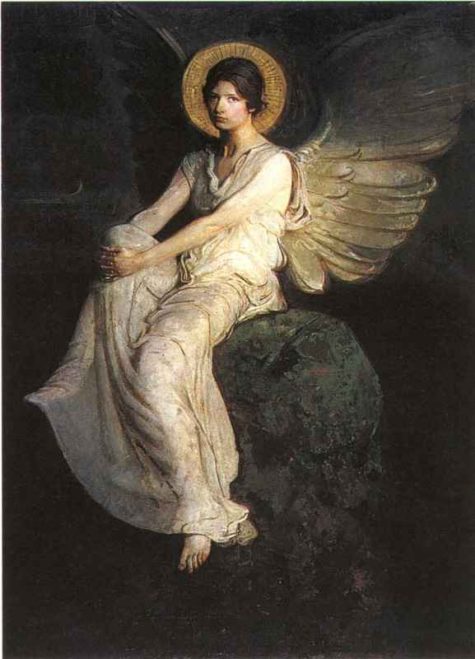
As with other mystical concepts, many legends surround guardian angels. Some people believe we have only one guardian angel at our side throughout this lifetime to help us make important decisions and protect us. Others believe each human has thousands of guardian angels.
Still others hold the belief that, although we have one angel assigned to us, others come to our aid when we are in deep trouble or when we begin various projects where their help can be of assistance. As one progresses spiritually, various angels may visit us at intervals, helping us along and teaching us what we need to know.
Finally some individuals believe that angels are our higher selves – the part of us that is spiritual in nature and attuned to the universe.
Whatever your beliefs, it is always beneficial to take time out to honor and give gratitude to the angelic spirits that guide and protect you.
In the ancient Roman calendar, October was the name of the eighth month of the year. Its name comes from octo, the Latin word for “eight.” When the Romans converted to a 12-month calendar, they tried to rename this month after various Roman emperors, but the name October stuck.
In Old England, the month was called Winmonath, which means “wine month,” for this was the time of year when wine was made. The English also called it Winterfylleth, or “Winter Full Moon.” They considered this full Moon to be the start of winter.
October Weather
A warm October is said to be a sign of a cold February. If leaves wither on the trees and fail to fall to the ground in autumn, it indicates a frosty winter with a great deal of snow, alternatively:
“If October brings heavy frosts and winds,
then will January and February be mild.”
The October Moons
The full moon closest to the Autumn Equinox is called the Harvest Moon, and as such, it sometimes falls in October. This moon is also called the Blood Moon, Hunters Moon, Shedding Moon or the Falling Leaf Moon. Coming right before Samhain, it’s a time when the nights are crisp and clear, and you can sense a change in the energy around you.
The Blood Moon takes its name not from blood sacrifices, but from the old custom of killing and salting down livestock before the Winter months made it impossible to feed them. Only the choicest stock was kept through the cold season.
Today we still subconsciously begin to make preparations for the coming Winter during this time. We check the antifreeze and tires for the car, gather up garden hoses, and make plans to winterize any drafty spots around doors and windows in the house. Some of us do and an ambitious fall cleaning.
October Magick
Throughout this month, festivals for the dead increase with the waning light, and late harvest festivals continue. The latter often include propitiation to ensure that the Goddess’s abundance will keep people whole through harsh or barren times.
Magical efforts accentuated by October’s characteristics include clearing away old, unnecessary things or habits so that our mind, body, and spirit are prepared for winter. Any spells for memory, especially commemorating loved ones, are apt. Beyond this, metaphysical efforts for health, luck, and debt paying seem common, ensuring that winter, the season of rest and death, will come and go with the least negative effect.
October Festivities
The Greek festival of Thesmophoria came every year in honor of Demeter and was confined to women only. This was a three-day rememberance of Kores return to the Underworld. At this festival the initiates shared a sacred barley drink and cakes. One feature of the Thesmophoria was a deterrent to offenders against the sacred laws against women. Priestesses read a list of the offenders before the doors of the goddesses’ temples, especially the temples of Demeter and Artemis. It was believed that anyone so cursed would die before the year ended.
The first day of the Thesmophoria was the kathodos, a ritual where purified priestesses took sacrificed piglets deep into the chasm where the sacred inner shrine of Demeter was. They left the piglets there and retrieved the remains of the one from the previous year. The second day was Nesteia, during which the remains of the retrieved piglets were displayed on the altar. Courts were closed in honor of Demeter as law-giver. On the third day, the retieved piglets were sown into the plowed Earth as a symbol of Demeter’s fertility aspect.
The Greeks also honored the god Hephaestus with an annual festival called Chalkeia.
In Tibet, the Buddhist Lent occured along with the Descent from Heaven festival which celebrated the end of the rainy season.
The Durga Puja in India honors the goddess Durga for four days beginning on the New Moon. It is a time of family reuntions, settling quarrels, and honoring the parents. In northern India this fesival is known as Dasahara. Durga is considered a matriarchal figure and is very popular with the people. She is shown with many arms and in bright colors.
The Lakshmi Puja, or Diwalii, is a fest of lights in honor of the goddess Lakshmi. It occurs right after the Durga Puja. During this Festival of Lights, lamos are everywhere, good things to eat are produced, and Hindu wives dance for their husbands. Lakshmi, wife of Vishnu, is considered the goddess of wealth and prosperity.
In the Pacific Ocean, the ancient Hawaiians celebrated a four-month long festival called Makahiki, beginning of the first Full Moon of this month. The god Lono had a special celebration of five days during this time, filled with games, pageantry, the hula, surfing, feasting, and tax collecting.
From:

